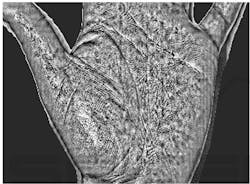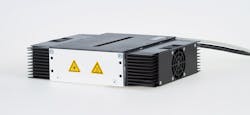Experimental Optical Scanning Device for Biomedical Diagnosis Uses Linescan Technology
Whether the goal is to perform medical imaging for dermatology or wound care purposes or to collect data for biometric applications, there's a critical need to collect images of the human body in a precise, repeatable, and high-quality manner.
Scientists at the Brno University of Technology1 (Brno, Czech Republic) have created a prototype of an optical scanning system based on line-scan imaging instead of a traditional 2D sensor. Leveraging the Chromosens Corona II LED Illumination module as the light source, the experimental system can change the field of view based on the diagnostic needs and allow the scanning of body parts of any size without having to change the physical configuration, whether the part is a finger, hand or entire arm.
Another advantage is that it doesn't require the patient to touch the scanning surface. Hygienic demands dictate that the devices used by multiple people need to be cleaned and disinfected at regular intervals, especially in the post-COVID era.
The lighting modules output a brightness of up to 3,500,000 lux with excellent homogeneity via a patented reflector design that shapes light, therefore eliminating chromatic aberrations. The university research team selected a 7-in. (190 mm) top light dark field module for their device with a minimum white illuminance of 800,000 lux.
Besides a line-scan camera equipped with a 2-in. (50 mm) f/1.8D lens and the Chromasens LED lighting, the optical scanning device employs a linear movement system, a Chromasens XLC4-1 LED control unit, a Raspberry Pi 3 single-board computer, and a microcontroller unit. It is capable of producing 350 dpi images of the variable field of view without having to make concessions to the quality due to its mechanical properties. It allows for objects up to 47 by 17 in. (120 by 43 cm) in size to be scanned while maintaining the 350 dpi spatial resolution.
The Chromasens XLC4-1 unit is controlled over a Telnet interface. A series of simple commands provided by the unit's documentation sets the intensity of Corona II lighting and turns the light module on and off. Commands to monitor the status of the illumination unit and the module were also used. The line-scan camera acquired 5,120 lines at a rate of 500 lines per second. It used the GigE interface and an API script was developed to handle its initialization, data grabbing, and image construction. Triggering and frame grabbing are performed using software scripts.
The device is mainly intended to be used for monitoring hand diseases and disorders, such as eczema, as well as various skin growths, such as nevus, to monitor their size and area. Images collected by the scanner are also of sufficient quality to perform recognition based on hand geometry if other biometrics are unavailable, for example, due to injuries such as a burn or skin diseases.
Founded in 2004 as a former division of Siemens AG, Chromasens GmbH designs, develops, and produces image-capturing and processing systems for stringent demands. Chromasens' expertise lies in the development of both components and systems. The optical, electronic, and mechanical elements of high-performance cameras and illumination systems are perfectly adapted to suit the specific tasks faced by each individual customer.

